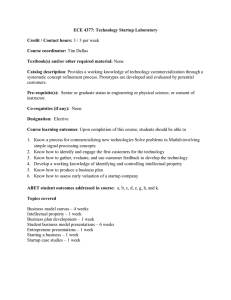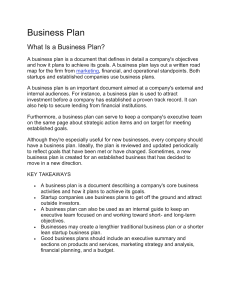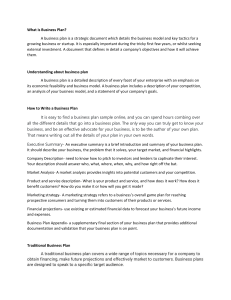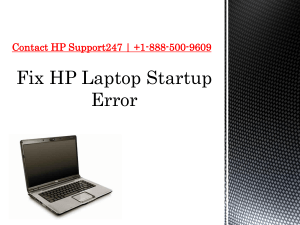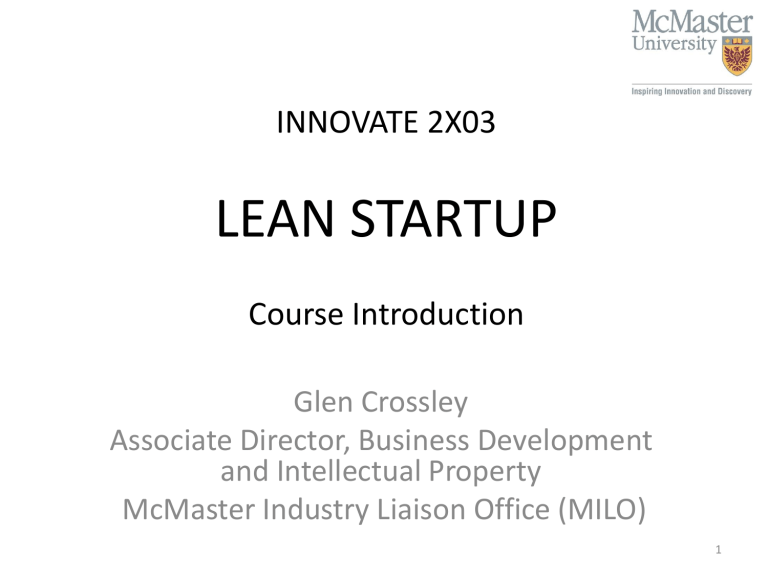
INNOVATE 2X03 LEAN STARTUP Course Introduction Glen Crossley Associate Director, Business Development and Intellectual Property McMaster Industry Liaison Office (MILO) 1 Agenda • Course Introduction – Glen’s background – Class Introductions – Overview of Course Outline – Problem Selection – Introduction to Lean Startup Methodology – Introduction/Review of Business Model Canvases 2 Introduction - Instructor • Instructor: Glen Crossley • Academic Background – BSc. and MSc. Eng. (Engineering Chemistry), Queen’s University • Work Experience – Group Leader, E Ink Corporation (1998-2002) • E Ink is an MIT start-up that developed the display technology in the Amazon Kindle, Kobo and other e-books – Director of Product Engineering, Photowatt Technologies (2003-2006) • Responsible for all aspects of New Product Development for a flexible solar technology 3 Introduction - Instructor • Current Role – Associate Director, Business Development and Intellectual Property, McMaster Industry Liaison Office (2006 –present) • Support faculty and students who want to commercialize their ideas • Sessional Instructor for Engineering Management 4A03 (2014 – present), Innovate 2X03 and 2Z03 • Set up and co-managed the Forge in 2014 before we hired full time staff 4 Course Details • Class Time: – Wednesdays 7-930 Virtual until Jan 25th, BSB 147 thereafter • Course Communication: – Innovate 2X03 website on Avenue to Learn – Innovate 2X03 Microsoft Teams Class – Email crosslg@mcmaster.ca • Administration – Program Coordinator – Anna Sciascetti – sciasce@mcmaster.ca • Course TAs • Claire Kim kimc49@mcmaster.ca • Marisa Manichan manicham@mcmaster.ca Hamza Mansour mansouh@mcmaster.ca • Keya Patel patek52@mcmaster.ca Julienna Kwong kwongj8@mcmaster.ca Brendalynn Rajkumar rajkumab@mcmaster.ca • Office Hours (TBD as needed) Please organize appointments by email or message me on Teams 5 Class Introductions • For the purpose of Innovate 2X03 you’ll chose a project to work on for the duration of the course • Historically have had people introduce themselves in class and the second class we talk about ideas people are interested in • For this class we’re going to do introductions by creating a short video on Flipgrid 6 Class Introductions • Will do class introductions on Flipgrid - an add Click here to access Flipgrid in for MS Teams Click here to record your video 7 Course Details • Define a problem worth* solving • Build a preliminary Business Model Canvas for your idea • Get out of the building (virtually) and test your hypothesis with real potential customers • Iterate on your business model canvas • Develop a preliminary financial plan, competitive analysis, market and IP assessment and work plan • Present what you have learned in a presentation and final report 8 Course Assessment • Introductory Video (5%) • Problem Definition and Initial Business Model Canvas (10%) • Preliminary Idea Pitch (5%) • Customer Interviews and Canvas Iteration (10%) • Market, Competition and IP Assessment (15%) • Financial Model and Work Plan (10%) • Pitch Presentation (15%) • Final Report (20%) • Peer Assessment (10%)* 9 What makes a problem worth solving? 10 Questions to ask yourself • How many people have this problem? • Why hasn’t the problem been solved before? • What do other solutions do/not do for the customer? • Who is the payer? • What might they be willing to pay? • How big is the customer pain/gain? • Is it scalable? 11 What type of Business do you want? • Growth business (create hundreds of jobs and change the world, make $$$) • Lifestyle business (be your own boss, make $$ and enable you to live the life you want to live) • Social Enterprise (make the world a better place, can still make $) 12 For Next Class • Think about what problem you want to solve • Try thinking outside the scope of problems facing just you and your housemates on a daily basis • We’ll spend the second part of class talking about problems people are interested in working on 13 Keys to a Successful Business 1) Have a compelling value proposition 2) Determine who your customer/user is 3) Figure out how you are going to get paid 14 2X03 Team Formation • Class Size 300 students • Team logistics – 6 students per team (about 50 teams total) – Try to be multidisciplinary – Enter your complete team or partial team on Avenue – You will be given a Team number, please use this number in all team related correspondence and copy all team members on all emails. 15 Peer Evaluation • My Challenge – Need a method to create a distribution of grades across the class that reflects understanding of course material and contribution • Option 1 – Peer assessment • Option 2 – Individual Test or Assignment 16 How have companies (large and small) historically developed new products and services? 17 Prior to ~ 2000 Waterfall Development 18 Stage GateTM Process • Robert Cooper, a Professor from McMaster’s Degroote Business School, is credited with developing two key concepts that are used by thousands of companies around the world over the last 20 years • A Stage-Gate ProcessTM – “Doing the projects right” • Portfolio Management – “Doing the right projects” 19 Stage GateTM Process 20 The Reality is… • Despite defined development processes, most new product launches fail! • Can be catastrophic if you are a startup • Can be equally devastating to large successful companies (share price can plummet, can lose market share, etc.) • Why? Two main reasons… • Let’s look at two phones Samsung launched in 2009 21 Customer Reaction to E Ink Samsung Alias 2 Released May 2009 https://www.youtube.com/watch?v=6f0Rkkp7cxQ 22 Customer Reaction to E ink 23 Reaction to a Different Phone Samsung Rogue Released Sept. 2009 https://www.youtube.com/watch?v=UbMp8aWwtLA 24 Reaction to a Different Phone 25 Why Do Companies Fail at Delivering New Products? 1. They don’t know who their customers are 2. They fail to deliver customers something they actually want Let’s look at some high-profile failures at fortune 500 companies… 26 Some Massive Product Failures Ranking Product Company Year 1 Edsel Ford 1957 2 Touchpad Hewlett Packard 2011 3 Crystal Pepsi Pepsi 1986 4 Clairol Touch of Yogurt Shampoo Proctor and Gamble 1979 5 Coors Rocky Mountain Sparkling Water Coors 1990 6 WOW Chips Pepsico 1998 7 New Coke Coca Cola 1985 8 Zune MP3 Player Microsoft 2006 9 Newton Message Pad Apple 1993 10 Arch Deluxe McDonald’s 1996 http://247wallst.com/special-report/2014/03/03/worst-product-flops-of-all-time 27 Edsel (Ford) 28 HP Touchpad 29 Crystal Pepsi 30 Clairol Touch of Yogurt Shampoo 31 Coors Rocky Mountain Sparkling Water 32 Wow Chips 33 New Coke 34 Zune 35 Newton MessagePad 36 Arch Deluxe! 37 So how do we avoid epic failures? 38 The Lean Startup 39 Definition of a Startup “A startup is a human institution designed to deliver a new product or service under conditions of extreme uncertainty” - Eric Ries 40 The Startup • Startups exist in companies of all sizes • The challenge is that they often don’t know who their customer is or what their product should be • Traditional management methods can lead to failure • A “just do it” approach does not lend itself to greater probability of success 41 The Basic Principles • The lean startup method argues that the success of a “startup” can be engineered by using a rigorous scientific method • Methodology is broken down into five core principles 42 Core Principles of the Lean Startup • • • • • Entrepreneurs are everywhere Entrepreneurship is Management Validated Learning Innovation Accounting Build – Measure - Learn 43 Entrepreneurs are Everywhere 44 Entrepreneurship is Management • The traditional method for product development is to execute on a detailed plan based on a series of assumptions • The Lean Startup Method advocates that the project team makes continuous adjustments through executing “Build, Measure, Learn” feedback loops • Consider Intuit and Turbotax with change from software you purchase to online solution 45 Validated Learning • “Demonstrating empirically that a team has discovered valuable truths about a startup’s present and future business prospects” – Eric Ries 46 IMVU Example • Eric Ries was the CTO of IMVU, a company trying to enter the instant messaging (IM) market in 2004 • Created an add on IM product that incorporated Avatars with people’s existing IM platforms to communicate with their friends • Spent millions on development and the end result was – nobody downloaded the product 47 IMVU • After a colossal failure, they brought in customers to trial the product • Got nowhere with mainstream customers – thought the product was too weird • But teenagers and early tech adopters loved it until… • They were told they were supposed to invite their friends to join them and download it as well! 48 IMVU • Out of total desperation they added a feature called “Chat Now” that randomly connected you with someone somewhere else in the world who simply pressed the button at the same time… • And people loved it. It turns out they wanted to use the avatar technology to make new friends on a new IM platform, not to communicate with existing friends on other platforms. 49 Build-Measure-Learn 50 MVP • "The minimum viable product is that version of a new product which allows a team to collect the maximum amount of validated learning about customers with the least effort” – Eric Ries • It allows you to put your product in the hands of early adopters and test your value hypothesis 51 Early Adopters • A subset of your potential customers who are generally forgiving, will provide critical feedback, understand your vision, and who like to be first 52 Early Adopters • Ideal for testing your vision (they can be as visionary as you are) • Not asking them what they think they want, showing them a concrete example or prototype (MVP) and get their feedback • Are they willing to pay? Is there a real problem that needs to be solved? • Will give you critical feedback 53 Innovation Accounting • Three Learning Milestones: – Use an MVP to baseline where you are at right now – “Tune the engine” by executing the build, measure, learn loop – Pivot or persevere • Important to measure the right thing, not “vanity metrics” 54 Pivot • Traditional definition of a Pivot – “Place one foot firmly on the ground and change direction” • Lean Startup – “A structured course correction designed to test a fundamental hypothesis about the new product, strategy and engine of growth” • Measure runway in terms of number of pivots remaining , not number of months or dollars in the bank, so the key is to learn how to get through design test learn loop faster. 55 Steeped Tea – A Great Pivot • A Hamilton Success Story • Started in 2006 when Tonia Jahshan and her husband travelled to the east coast, sampled an amazing loose leaf tea at a B&B, then went on to build a multimillion dollar business • But it didn’t start easily…. 56 Steeped Tea • Partnered with David Chilton and Jim Treliving from Dragon’s Den • Ranked #17 on Profit 500’s list of fastest growing companies in 2015 • Employ more than 9000 entrepreneurs in Canada and expanding into US • Tonia Jahshan named Canada’s top female entrepreneur in 2016 57 Summary • Stage-GateTM product development processes can work well in established companies launching products to existing customers (but can still fail) • The Lean Startup Method is rapidly increasing in popularity in companies large and small that uses a rigorous method to test the hypothesis that you are building a product customers actually want. 58 Business Model Generation 59 Business Models • In today’s economy the business model itself can be as important as the new product or service • Many new businesses find their success in a new business model such as Amazon.com, and even locally, Steeped Tea (now Sipology). 60 How do you create new business models? Alex Osterwalder 61 Nespresso 62 Definition of a Business Model “A business model describes the rationale of how an organization creates, delivers and captures value” - from Business Model Generation, Alex Osterwalder and Yves Pigneur 63 Business Model Canvas • A Business Model Canvas is a visual tool that helps you create or think through the business model for your company, your competitor or virtually any enterprise • Divided into 9 key “blocks” that cover the four key areas of: – – – – Your customers What you offer Infrastructure Financial viability 64 9 Building Blocks • • • • • • • • • Customer Segments Value Propositions Channels Customer Relationships Revenue Streams Key Resources Key Activities Key Partnerships Cost structure 65 Customer Segments • Defines the groups of people or organizations the company aims to serve – for whom are we creating value? • Different segments if: – Their needs require (and justify) a distinct offering they are willing to pay for – Reached through different Distribution Channels – Require different kinds of Customer Relationships • Examples of customer segments include mass market, niche market, segmented, multi-sided etc. 66 Value Proposition • Describes the combination of products and/or services that create value for a specific customer segment- what problem are you solving and what is your solution? • Value proposition may include newness of features, improved performance, customization, lower price, design, brand, accessibility, risk reduction, etc. • Can be multi-sided 67 Channels • How the company reaches its customers to deliver its value proposition • Includes phases (awareness, evaluation, purchase, delivery, after sales support) • Types include direct (eg. sales force, web sales) or indirect (own stores, partner stores, wholesaler etc.) • B2B, B2C 68 Customer Relationships • The relationship a business creates with a specific customer segment • Customer acquisition • Customer retention • Examples of customer relationships include personal assistance, self or automated service, communities of uses, co-value creation (amazon, youtube, airbnb) 69 Revenue Streams • How a company generates cash from a specific customer segment • Generally two main types – One-time transaction for the good or service – Recurring revenue for continued service or customer support • Revenue streams may include product sale, usage fees, subscription fee, renting/leasing, licensing, advertising etc. 70 Key Resources • The most important assets needed to make the business model work • Physical • Intellectual Property • Human • Financial Resources 71 Key Activities • Describes the most important things a company must do to execute on and make its business model work. Examples include: – Design – Production – Problem Solving – Building/Maintaining a platform or network 72 Key Partnerships • The key partners and suppliers that make your business model work • Types of partnerships may include – – – – Strategic Alliances between non-competitors Co-operation between competitors Joint ventures (often to create new businesses) Buyer/Supplier relationships • Motivation for building partnerships can include things like economies of scale, risk reduction, acquisition of particular skills etc. 73 Cost Structure • The cost structure block describes costs associated with executing the business model • Two main types of business models – Cost driven – Value driven – Many business models fall somewhere in between • All businesses should drive to reduce costs, but it is much more critical for cost-driven business models than value-driven models • Costs structure can depend on fixed costs, variable costs, economies of scale, etc. 74 The Business Model Canvas 75 Example - Tesla 76 Key Partners 77 Key Activities • Design and build key electronics components of electric vehicle • Sell directly to customers around the world • Manage service centres • Build and operate Gigafactory in collaboration with Panasonic to bring battery manufacturing under one roof • Manufacture and cell solar modules and systems 78 Key Resources • Top tier Senior Management Team led by Elon Musk (?!) • Located in Silicon Valley to access top engineering talent (should be in SW Ontario…) • R&D and manufacturing capability • Intellectual Property? 79 Value Proposition • Initially high-end sports and luxury vehicles with the highest level of safety and environmental friendliness • Vision is now electric vehicles for mainstream market with Model 3 • Longest driving range of an electric vehicle (>200 miles) • Home battery storage for renewable energy 80 Customer Relationships • Setting up charging stations across the world • Seamless software update for recalls • Improved dealer experience 81 Channels • Direct sales through Tesla owned stores around the world • Online purchases • Challenges? 82 Customer Segments • Current customers are high-end environmentally conscious customers (niche) • Targeting mainstream customers as costs come down (mass market) • Also planning to sell battery solutions to homeowners for domestic use • Others? 83 Cost Structure • Manufacturing costs for electric vehicles • Government subsidies for plant and vehicle purchasers • Batteries are significant cost • Cost of setting up dealerships 84 Revenue Streams • Sale of electric vehicles • Licensing of powertrain design to other electric vehicle manufacturers • Sale of Powerwall product • Others? 85 Pick a Company and Create their Business Model Canvas 86 The Business Model Canvas 87 Other types of Business Models • Freemium – Skype, Linked In • “Bait and Hook” – Mobile Phones, Ipod/Itunes, Razors • Open source – Red Hat • Others? 88 Questions? 89
